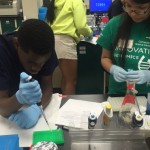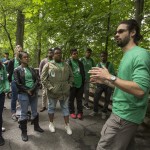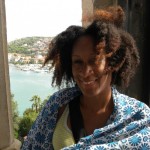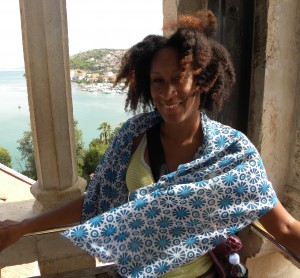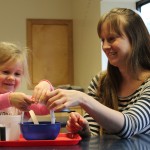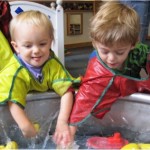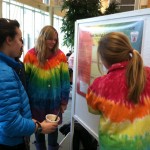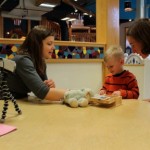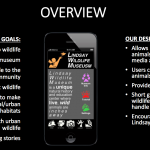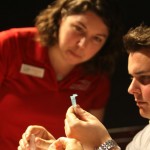Author Archive: SENCER-ISE
SENCER-ISE University of Connecticut and Connecticut Science Center Partnership Featured on CAISE Blog
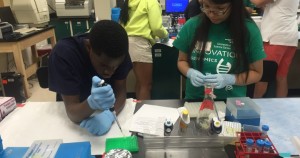
Photo credit: Stephanie Airoldi
The partnership between the University of Connecticut and the Connecticut Science Center, supported by SENCER-ISE, has been featured in the CAISE (Center for Advancement of Informal Science Education) Perspectives Blog as part of its Museum/University partnership series.
Rachel O’Neill, professor and head of Genetics and Genomics at the University of Connecticut, and Hank Gruner, Vice President of Programming at the Connecticut Science Center are partnering to increase genomic literacy.
Learn more about University of Connecticut and Connecticut Science Center’s goals, challenges, future plans, and more in their blog post.
Fordham University and Wildlife Conservation Society Partnership Featured on CAISE Perspectives Blog
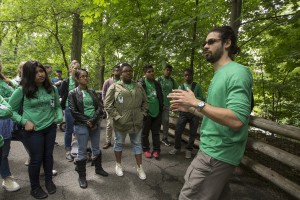
NYC high school students learn about urban ecology from a Fordham University student. Photo credit: Bud Glick
The SENCER-ISE partnership between Fordham University and the Wildlife Conservation Society is featured on the CAISE (Center for Advancement of Informal Science Education) Perspectives blog. The partners discuss their collaboration on Project TRUE: Teens Researching Urban Ecology, which uses a tiered-mentorship model to introduce New York City high school students to urban ecology and increase the rate of students pursuing STEM majors by facilitating collaborations with college mentors already in STEM disciplines.
Continue reading to lean more about the Fordham University and the Wildlife Conservation Society’s partnership and Project TRUE.
This is the third installment of SENCER-ISE’s mini-Spotlight series as CAISE continues to highlight university and museum collaborations. Click to read previous posts about the SENCER-ISE initiative, and the Cornell University and the Sciencenter partnership.
Professor Jennifer Adams on the Benefits of Informal Science and Place-Based Education
Jennifer D. Adams, an associate professor of Science Education and Earth and Environmental Sciences at Brooklyn College and one of the co-investigators for the SENCER-ISE supported project, Sentinels of Shoreline Change, was recently featured in Brooklyn College Magazine’s issue on “Women Who Shape the World”, a broad-ranging article on social and academic challenges faced by girls and women. In the article, featured on page 14, Adams points to the Lang Program, a seven-year extracurricular program for students from the fifth through twelfth grade offered through the American Museum of Natural History. The program engages students in learning science in “hands-on” classroom settings, and through research projects and career exploration. Adams helped initiate the program around the year 2000 and has examined the benefits participation in Lang brings to students, especially to young women. She concludes that, “the spaces where a lot of young women are finding their scientific voices are these out-of-school learning activities.”
In response to our questions about her work, Adams recently placed her involvement with the Lang program in the context of the role of informal education and its links to the more formal classroom:
What is your teaching specialty at Brooklyn College, within the science education program?
My specialty is informal science education and place-based education. I focus both on educating teachers to use out-of-classroom resources to teach and learn science and also students who are interested in being educators or researchers in informal science settings.
You note that “out-of-school experiences tend to yield better results in terms of inclusivity of young women and girls” and offer opportunities for students to learn more about different career options in the sciences. How can a project such as your SENCER-ISE one provide tools to classroom teachers to encourage students in science? Can such a model be used in teacher education programs?
By introducing teachers to informal spaces and places through teacher education and professional development, teachers learn about different ways of participating in science and different career paths, and could then share these with students. Thoughtful teachers are always looking for ways to extend the classroom learning experiences whether through field trips or through learning about extra curricular opportunities for their students. For many students, it is the teachers who introduce them to these expanded learning opportunities in out-of-school settings (like museum afterschool programs) as recruitment for these programs is often done through teachers and schools. For our SENCER ISE project, we are introducing teachers to a local national park through place-based, citizen science activities. It allows both them and their students to see both science and their local places through a different lens.
Are there aspects of the Lang program that can be incorporated into a classroom setting?
I helped to initiate the Lang program around the year 2000 and it has greatly evolved since. The Lang program uses project-based, collaborative approaches to engaging kids in science. Those approaches could be implemented in classrooms even with the constraints of time and curriculum. It is about engaging students in their own question posing, data collection and analysis, and presentation of their work to an extended audience. It is also about the collaboration; getting students to work with each other and alongside teachers and other people (like rangers in a National Park setting or a field scientist) as they learn. When I work with teachers, I always encourage them to make adjustments to a single lesson, for example, integrating questioning strategies or posing a simple problem for students to discuss, to try a new approach rather than transforming a whole unit at once. This gives a teacher an opportunity to reflect on implementation and build a repertoire of successful reform-minded approaches over time.
Would you like to add anything else about the role of “out-of-school” experiences?
It is vital to have a continuum of learning experiences from formal to informal if we want to engage our students in rich, meaningful, and relevant science learning experiences. A continuum allows for multiple ways of participating in science–the school allows for a broad engagement in a lot of topics while informal science learning environments allow for a deeper engagement in a particular interest.
In sum, with informal science education’s emphasis on place-based, project-based, and collaborative learning, the connection enriches the educational experience and provides more opportunities for students to learn about real life applications of science that can engage them and also help them find a niche for themselves in STEM fields. Teacher education and teacher professional development initiatives can incorporate elements of informal science education into their programs.
Sciencenter and Cornell University Partnership Featured on CAISE Perspectives Blog
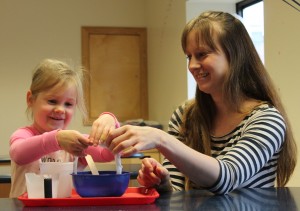
Research is highlighted at a Sciencenter Family Workshop where Cornell University students and ECC Lab researchers work with young participants. Photo credit Sciencenter
The Sciencenter and Cornell University partnership has been featured on CAISE’s Perspectives blog as part of its Spotlight series on university and museum partnerships. This is a follow-up to SENCER-ISE’s Spotlight post in March 2015.
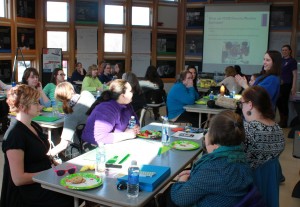
Sciencenter educators, Cornell University students and ECC Lab researchers conduct a workshop for Head Start teachers.
The Cornell University’s Early Childhood Cognition Lab and the Sciencenter are partnering to research early childhood learning and share their findings with parents, caregivers, and teachers. Continue reading to learn more about the partnership and its work.
Kelly Yang, Cornell Senior, Researches Early Childhood Learning
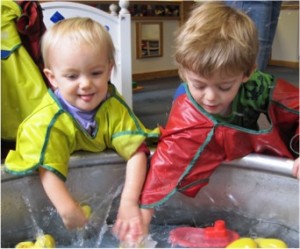
Visitors at the Sciencenter splash around in a Curiosity Corner exhibit-an area specially designed for children 4 years and younger. This will be one of the water exhibits featuring the new signage. Photo by Sciencenter.
How and when we learn is not determined by a class schedule. With most of our lives spent outside of a classroom, more attention should be paid to the learning that takes place in the “real world.”
Kelly Yang, a senior majoring in human development and minoring in biological sciences at Cornell University, is doing just that. Kelly has been a research assistant in Cornell’s Early Childhood Cognition Lab (ECC Lab), directed by Dr. Tamar Kushnir, since her freshman year.
ECC Lab researchers design toys, games, and stories to study how children learn. These tools are implemented in the lab, at local schools, and at informal science education institutions like the Sciencenter.
Cornell’s ECC Lab and the Sciencenter are partnering to research early childhood development and how caregivers interact with children during the learning process. The partnership aims to ultimately create and provide caregivers with the tools needed to maximize their child’s learning.
The partnership’s SENCER-ISE-funded research began with Dr. Kushnir’s Spring 2014 Concepts and Theories in Childhood course, in which, students worked with Sciencenter director of education, Michelle Kortenaar, and museum staff to conduct research on how children interact with caregivers and museum exhibits.
The Concepts and Theories course stood out among Kelly’s other courses because it provided her with the opportunity to actually apply her knowledge and course work in the field. Kelly says she “thinks it’s great for undergraduates; especially juniors and seniors, to get a feel for how their academic backgrounds will come into play in their future jobs and careers.”
Recently, Kelly took the time to reflect on her work the the ECC Lab and the Sciencenter:
A 5-year-old boy stands next to me and together we gaze at some red and white, Frisbee- and spherically-shaped objects. We are at the Sciencenter, looking at an exhibit about blood. I ask, “What is that stuff?”
With his five-year-old lisp, he responds matter-of-factly,“They’re red and white blood cells.”
“What do they do?”
“The white blood cells, they protect your body. And the red ones, they carry oxygen.”
“Oh cool…what else is in the blood?”
“T Cells and B Cells. They fight the bad guys. Like ninjas!”
—
As a research assistant in Cornell’s Early Childhood Cognition Lab, I am repeatedly amazed how well-equipped we are to learn from a young age. The five-year-old boy in the anecdote above knew middle school-level biology simply from being around his dad, who is a scientist at Cornell. In the Lab, we examine children’s learning and thinking using activities and games specifically designed for a controlled lab setting. This summer, I worked at the Sciencenter, a hands-on museum in Ithaca, NY to develop a new project for the Lab. This project examines children’s learning in the organic and messy real world to see how they learn in informal learning environments.
It is understood in the field of developmental psychology that children use concepts and categories to make sense of the world around them. If an adult presents a child with a blue sphere and a red sphere and labels both with the word “ball”, a child can infer that “ball” refers to a category of objects that are round. To apply this idea in the real world, we are connecting several museum exhibits that share the concept of “water”.
Mariel Schneider, an Early Childhood Cognition Lab alumnus, began working on this project last summer. She focused on using signage to bring attention to the concept of water. This year, Dr. Tamar Kushnir’s class on Concepts and Theories in Childhood brainstormed to further Mariel’s work. As part of the class, students observed caregiver-child interactions at various exhibits that all shared the theme of water. The class collectively decided that the project was in need of an interactive component. Our idea was to use a scavenger hunt to highlight the water concept, and my goal for the summer was to create it.
While at the Sciencenter, I prototyped a number of activities and steps on the museum floor. I ultimately found that children enjoy doing crafts and having something to take home. I created pocket-sized booklets for children to use in the scavenger hunt and take home afterwards. I also designed custom stampers to use for the scavenger hunt throughout the museum. In addition to working on the Lab’s project, I helped the Sciencenter’s education team run and assess early childhood programming, looking for ways to engage parents and caregivers in their children’s science learning. I also had the opportunity to lead a professional development workshop for Sciencenter staff and share my knowledge of current research in early childhood cognitive development.
This summer, the amount of creative freedom that the project allowed me helped me to grow in my learning and thinking. It was challenging and immensely rewarding to apply my knowledge outside of the classroom. My experiences at the Sciencenter are invaluable to my future career as a pediatrician because not only am I prepared to work with children and their parents, but also prepared to discuss relevant issues in the workplace.
Moving forward, I along with a team of other research assistants will be collecting data on the scavenger hunt game throughout the following semester. We hope to learn more about caregiver-child interactions and gain insight into concept formation in a museum setting. My summer at the Sciencenter was pivotal in laying the groundwork for this project and I am eager to see how the rest unfolds.
Through her research, Kelly has also observed the advantages of informal science education. Kelly had always appreciated informal science education institutions and environments, but she now has a “much deeper appreciation of all the careful thought and planning that goes into creating museum programs and exhibits.” She remarks that she’s always been “interested in education, but now informal education is even more appealing since there is so much room for creativity.”
Hamilton College and Green Science Policy Institute Welcome Hope and Oberlin Colleges to their SENCER-ISE Partnership!
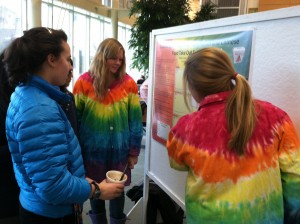
Toxic Posters: The campus community is invited to a poster session in which students present the results from their analytical assessment of exposure to toxic chemicals from consumer products. Photo: Tim Elgren
This past spring, Dr. Tim Elgren, originally the SENCER-ISE Co-PI at Hamilton College, was appointed as the Dean of the College of Arts and Sciences at Oberlin College in Oberlin, OH. Dr. Elgren and his partner at the Green Science Policy Institute (GSP) in Berkeley, CA, Dr. Arlene Blum, saw Dr. Elgren’s new position as an opportunity to expand their existing partnership to include two new colleges.
Last academic year, Drs. Elgren and Blum, along with Ms. Avery Lindeman of GSP, built upon Dr. Elgren’s existing Hamilton College Introduction to Chemistry course into a toxicology lab with elements of civic engagement to provide students with opportunities to share their research with the public.
The partners and SENCER-ISE staff are excited to expand the collaboration to include Hope and Oberlin Colleges.
Dr. Adam Van Wynsbergh, assistant professor of chemistry, is taking on the toxicology curriculum at Hamilton College, with Dr. Greg Rahn, instrumental specialist, contributing to the development and teaching of the labs.
Components of the toxicology lab developed by Hamilton College and GSP will be adapted by Dr. Graham Peaslee, professor of chemistry, to create a similar course at Hope College in Holland, MI.
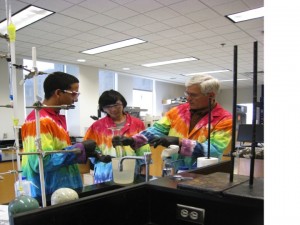
Basic chemistry, such as chemical partitioning, is introduced early in the term to help students design strategies for separating toxins from various materials before quantification is possible. Photo: Karen Brewer
Dr. Elgren will be teaching a version of the course at Oberlin College.
Drs. Blum, Elgren, VanWynsbergh, and Peaslee will also be collaborating to further refine and disseminate the toxicology-focused model for introductory chemistry students and the undergraduate curriculum.
Dr. Ellen Mappen, SENCER-ISE Project Director, knows how important institutional backing is for cross-sector partnerships. Dr. Mappen says, “It is imperative that these collaborations support the partner institutions’ missions and have support of the organizations. If they do not have this, the partnership will not survive a personnel change.” She adds, “We are so happy that the Hamilton College and Green Science Policy Institute’s partnership not only survived Dr. Elgren’s transition to Oberlin College, but has also expanded to include Hope and Oberlin Colleges.”
Innovative Pilot Study Seed Grant Awarded to SENCER-ISE Co-PIs
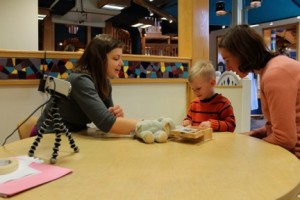
Graduate student from the Early Childhood Cognition Lab, Nadia Chernyak, conducts a study with child participant. Photo by Sciencenter.
Dr. Tamar Kushnir, professor and Director of Cornell University’s Early Childhood Cognition Laboratory (ECCL), and Michelle Kortenaar, Director of Education at the Sciencenter, were recently awarded a 2014 Innovative Pilot Study seed grant from Cornell University’s Bronfenbrenner Center for Transitional Research (BCTR)
to implement their project The Science Word Scavenger Hunt: Design, Implementation, and Assessment of a Simple Interactive Museum Experience to Engage Young Children and Their Families in Science Learning.
The goal of the Innovative Pilot Study Program is to encourage shifting social and behavioral research into real-world practice and policy. The BCTR awards approximately four to five pilot grants a year for up to $12,000 each.
The Science World Scavenger Hunt is an extension of the work done by Dr. Kushnir and Ms. Kortenaar on their SENCER-ISE project Science from the Start: Engaging Researchers, Undergraduates and a Science Museum to Reach Early Learners and Set the Stage for STEM Learning.
In the Science from the Start project, Cornell University undergraduates in Dr. Kushnir’s Concepts and Theories in Childhood course study early childhood cognition, designprototype signage for Sciencenter exhibits (this past semester, these signs dealt with the concept of water), and observe visitor interaction with the signs and exhibits. To encourage visitors to engage more with the signage created through this project, a scavenger hunt with the theme of “water” is being introduced.
When making their visitors observations, the students took an unobtrusive “fly on the wall” approach. The BCTR grant provides the funds to allow formal data collection by ECCL researchers on how children and parents — some taking part in the scavenger hunt, others not — interact with each other and the exhibits. Researchers from the ECCL will videotape parent-child interactions at different exhibits throughout the Sciencenter and code the resulting data.
A National Science Foundation grant will be written for the summer of 2015 based on this pilot data.
As Dr. Kushnir and Ms. Kortenaar say in their grant proposal, researchers have studied the mechanisms of childhood learning in controlled laboratories, but little focus has been put on how learning takes place in real-world environments.
Ms. Kortenaar states, “By partnering with Cornell’s Early Childhood Cognition Lab, the Sciencenter seeks to enhance the early childhood experience at the museum and also to empower parents, educators, and other caregivers to take an active role in their children’s early learning. Through this partnership, we are succeeding on both counts.” She goes on to say, “Our youngest guests have a fun-filled learning experience, while their parents and caregivers are inspired to engage their children in ways that complement their children’s natural curiosity.”
Wildlife Mobile App Now Available for Download
Saint Mary’s College of California and the Lindsay Wildlife Museum have announced the launch of their wildlife education mobile app, which is now available for free download in the iTunes store!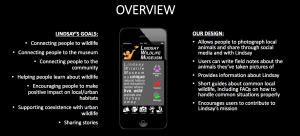
Saint Mary’s School of Science students developed the mobile app with the guidance of Lindsay Wildlife Museum staff. Read about the app’s development in their June 4th web post, and read Saint Mary’s College and the Lindsay Wildlife Museum’s full press release.
The Partners Prepare for Summer Programming
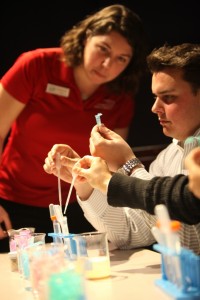
Stephanie Airoldi of the Connecticut Science Center works with adult visitors. Photo by the Connecticut Science Center.
Dr. Rachel O’Neill of the University of Connecticut, Mr. Hank Gruner of the Connecticut Science Center, and their colleagues have been preparing for the Genome Ambassadors public programs that will take place at the Science Center over a five-week period beginning July 7, 2014.
The Genome Ambassadors programs will focus on conducting surveys and hands-on genomic- and genetics-related activities with families visiting the Science Center to gauge public awareness and understanding of the principles and concepts of the field. The information collected will be used to guide the design and development of a 2,500 square foot genomics installation that the Science Center is planning for the next few years.
In preparation for the public programs, the team conducted a literature search to define the key genomic principles for public understanding, built pubic assessment activities, and established a graduate student fellowship program, which supports two Ph.D. students in their training to undertake research and outreach activities in Genomics Literacy.
Local high school students, taking part in a six-week genomics program at the Science Center, will be working with a staff member to develop and test pilot genomics- and genetics-related activities for family audiences. These activities, along with the public assessment work that will be done by the University of Connecticut graduate students, will be implemented in the Science Center’s Health and Sports exhibit gallery.
This collaboration between the high school and graduate students is a recent development that came about in a planning meeting to further develop the program schedule and activities. Gruner noted that, “We like the tie between the summer genomics program for high school students and the SENCER-ISE graduate student project as it broadens the experience for all involved.”
The two groups of students will work together on the Science Center floor presenting activities to the public that embed the survey work with hands-on learning experiences. The opportunity to connect high school students with an interest in genomics-related careers with university graduate students studying genomics was too great an opportunity to miss and benefits both groups of students. Through this program, the high school students will engage with their “near peers”, get to explore career options in genomics and post-secondary education, build their confidence in working with the public, use the information gathering from the collected data to guide the development of the activities that will refined over the summer, gain content knowledge, and build a new awareness of the field of genomics. The graduate students benefit by enhancing their science communication and mentoring skills while guiding the high school students and interacting with the museum visitors.

